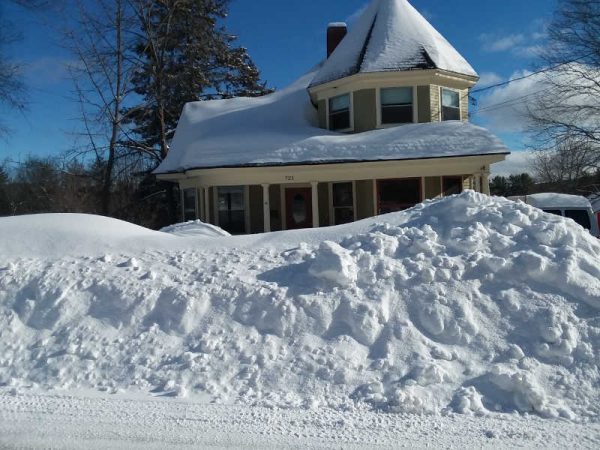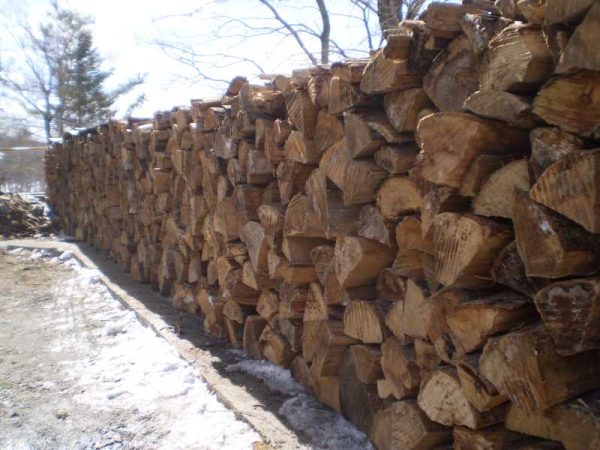A Kingdom Where The Sky Is Burning

Well, now that we’ve warmed up with lots of talk about firewood, I’ll going to pull the rug out from under you. I apologize in advance for that, and for the pun, too. We don’t burn firewood anymore.
We haven’t for a while now. It was the only way we could figure out to avoid freezing and starving here in the hinterlands. It’s bad manners to freeze and starve at the same time, I think. Smacks of an inability to make up your mind. So we had firewood for heat and ate peanut butter a lot and got by.
I could wax poetic about fires, if you like. I used to rouse myself at around 3 AM and go down in the basement in the dead of winter. I always loved that term, the dead of winter. There are two or three weeks here in late January where the daytime and nighttime temps don’t budge. The average is something like low 20s in the day and 6 at night. It just hangs there like that until a day or two into February when the average ticks up one degree, and you know the sun is spinning properly and the earth is tilting a smidge and you’re coming out of it. It’s generally those three weeks when you see -20F at night, and sometimes the daytime temp never cracks zero.
So I’d get up a half an hour before I went to bed, I think. I’d shuffle through the chilly kitchen, and stand for a long moment at the top of the stairs, and look out over the landscape. There’s no moisture in the air at those temps, so everything is as clear as the instructions for a hammer. If the moon is out, the bare trees spray their shadows over the snow in perfect relief, and you can’t tell what’s the tree and what’s the shadow sometimes. There are more stars than you’re used to. They were sprinkled nicely on the firmament in summer, but they’re blasted all over in the winter. There are so many that they seem to be holding hands. It’s too cold for anything to be out and about, but you look for foxes and fishers and moose and bears and deer just the same.
If you get up a little later, the sun puts on a show just over the horizon. It slinks behind the mountains and lights up the sky with delicate pinks and powder blues, with more than a hint of Maxfield Parrish in them. But you can’t linger. Down the stairs to the furnace, to make a fire.
When you’re really burning wood for heat, not just amusing yourself, you can make the old joke that this winter was so mild that you only needed one fire. It lasted from Halloween to St. Patrick’s Day, but it only took one match.
It’s really cold in the basement. We keep the rat run from the water meter to the water heater just above freezing, and leave the faucet dripping all night in the kitchen to keep the pipes from freezing. The first glass of water in the morning was kind of slushy sometimes.
I placed an overturned milk crate in front of the furnace door. There were buckets filled with junks of firewood nearby, placed there the afternoon before, because you don’t want to go outside until the sun is full up if you can avoid it. It takes twenty to thirty minutes to make a fire, and you can’t force the issue. Lord knows I tried, and failed, to hurry it up. It just does.
The fire looks dead out but it ain’t, unless you slept overmuch. You take a poker and rake through the coals, and they brighten up a bit. I coveted anything that could start a proper fire. Paper of any kind immediately got scarcer than a husband when the dishes need washing. My wife would collect egg cartons for me, the gray kind made of cellulose. I’d tear them in half. I’d go in the cutoff box from making furniture and such and fill the little egg holes with little bits of pine and curly maple and cherry and whatever else was in there. You’d lay some paper in, but twisted, so it wouldn’t ignite immediately. Then you put the egg trays on top of the paper, and then a few sticks of kindling. Then you plopped the three or four logs from the bucket on top, while trying not to smother the whole thing. Open the ash door on the bottom of the stove, and you’re in business. You hope.
Opening the ash cleanout door lets air underneath the coals, and if you did it right, the the whole thing comes alive without a match or any fussing. Do it wrong, and you have to take the whole mess out and start over in the cold.
This is when the cat would come out of nowhere and sit in my lap. Cats just know these things. The fire would start to perk up, and the heat coming out of the open furnace door was instant summer. The bottom door has to be closed as soon as possible, and judging the knife edge between the fire going out and a four alarm fire got to be an art. There is a cast iron spinner on the ash dump door, that lets in a little air after you close the door, but if you’re doing it right, you can close it. There’s a little air inlet in the firebox you’re supposed to fiddle with. I think it’s there to keep you busy, like a mobile over a crib.
The fire really gets going, and the jacket on the furnace creaks and groans like an uncle sitting down after Thanksgiving dinner. You wait and shiver until the temps in the chase between the firebox and the outside of the stove gets hot enough to trip a switch, and the big fan wakes up and starts blowing air up into the house, and you can go upstairs. In two or three hours, you can go down and simply drop more logs on top of the existing fire, and keep the thing going like that until you falter and fall asleep, and then it’s back to raking through the coals again.
A five-gallon pail holds a single fire. We began to refer to days as “Six bucket days” or “eight bucket days” after looking at the weather and guessing a bit. On really cold days, you’d need twelve of them lined up. As E.B. White said, in Maine, winter is a full time job.
We did what we had to. We hung curtains in parts of the house to cordon them off from the heat we were hoarding elsewhere. For about a year, we put a thick sheet of foam insulation in the stairwell and abandoned the second floor entirely. My wife and I slept in our clothes sometimes. We turned on electric baseboard heat in the kid’s rooms at night, because kids shouldn’t suffer for their parents mistakes, should they? I could always rob a convenience store or something when the electric bill came, I thought.
And through the whole escapade, I patted myself on the back for my mental fortitude. By that, I mean I resisted the urge to climb inside the furnace each and every time I lit a fire. And for the whole twenty or thirty minutes it took the flames to infect the paper and the kindling, and creep up and over the logs in a wave, I daydreamed of sleeping four hours at a stretch. There was only one thing to do. Buy a pellet stove.

[To be continued. Thanks for reading and commenting and hitting the tip jar. It is much appreciated]



Recent Comments